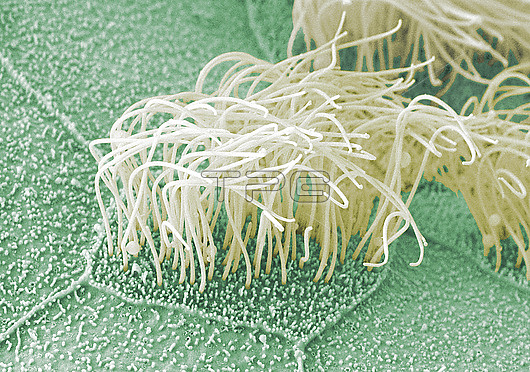
Ciliated cells on skin of Iberian ribbed newt larvae, coloured scanning electron micrograph (SEM). The skin of the Iberian ribbed newt larvae, also known as the gallipato or Spanish ribbed newt, (Pleurodeles waltl) contains many ciliated cells. Cilia are small hair-like protuberances that can be found on the outside of eukaryotic cells. They are primarily responsible for locomotion, either of the cell itself or of fluids on the cell surface. On the surface of the skin of newt larvae they play an important role in directed fluid flow. The skin of the amphibian embryo quickly develops many ciliated cells that generate a directed fluid flow. Ciliated cell differentiation is precisely controlled ensuring that the cells are distributed across the epidermal surface at high density in an evenly spaced pattern. A large proportion of respiration of amphibian embryos and larvae takes place through the skin, so cilia driven fluid flow is thought to be critical to continually replenish oxygenated water. To generate a robust flow, the ciliated cells have a uniform orientation of ciliary beating so they must be polarised relative to each other within the cell. Over recent years, researchers have worked to develop the ciliated epithelia of the skin of amphibians as a model system for understanding the development of ciliated cells and their ability to generate directed fluid flow. Magnification: x3700 when printed at 10cm wide.
| px | px | dpi | = | cm | x | cm | = | MB |
Details
Creative#:
TOP29066799
Source:
達志影像
Authorization Type:
RM
Release Information:
須由TPG 完整授權
Model Release:
Not Available
Property Release:
Not Available
Right to Privacy:
No
Same folder images:

 Loading
Loading